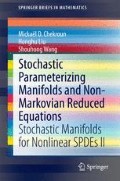Abstract
In this chapter, we consider a new stochastic PM candidate obtained as the pullback limit associated with the two-layer backward-forward system of Chap. 4; and we illustrate that the corresponding reduced system, when applied to the stochastic Burgers-type equation introduced in Chap. 6, provides better performances in modeling the dynamics of the resolved modes when compared with those achieved by the reduced system based on \(\widehat{h}^{(1)}_\lambda \). Methodological aspects are presented in Sects. 7.1 and 7.2, where a numerical procedure is described to determine “on the fly” the reduced random vector field (based on \(\widehat{h}^{(2)}_\lambda \)) along a trajectory \(\xi (t,\omega )\) generated by the latter as the time is advanced. This method is particularly useful when no analytic formulas of \(\widehat{h}^{(2)}_\lambda \) are available. The substitutive cornerstone in this case, is the pullback characterization of \(\widehat{h}^{(2)}_\lambda \) given by (4.45), which allows us to update the reduced vector field once \(\xi (t,\omega )\) is known at a particular time instance \(t\). As illustrated on the stochastic Burgers-type equation, it is shown in Sect. 7.5 that the statistics of the large excursions present in the SPDE dynamics projected onto the resolved modes are reproduced with a very good accuracy from simulations of the reduced dynamics based on \(\widehat{h}^{(2)}_\lambda \).
Access this chapter
Tax calculation will be finalised at checkout
Purchases are for personal use only
Notes
- 1.
This trajectory is determined in practice by the initial datum \(\phi \) used for the reduced system, which itself depends on the initial datum \(u_0\) used for the SPDE simulation; see also Remark 6.3.
- 2.
The latter give indeed access to approximations of \(\widehat{u}^{(2)}_{\mathfrak {s}}[\xi _t](T+t, \theta _{-T}\omega ; 0)\), which in turn is aimed to approximate (when \(T\) is sufficiently large) the parameterizing manifold function \(\widehat{h}^{(2)}_\lambda \) evaluated at \(( \xi (t,\omega ), \theta _t \omega )\).
- 3.
For the sake of the discussion here, we have changed \(T\) in (4.50) by \(\tau \) here.
- 4.
Which falls within the same basin of attraction of a stable stationary solution; see Sect. 6.1.
- 5.
See Fig. 7.2 for \(\lambda =1.7 \lambda _{c}\).
- 6.
See discussion after (7.35).
- 7.
The PDFs as simulated from a two-mode Galerkin reduced systemReduced equations!Galerkin are not shown in Fig. 7.4, since, for instance, the estimated PDF of the second mode SPDE dynamics is overestimated by a factor of three, from such a reduced system.
- 8.
Regime A considered in Chap. 6 and Regime B considered in this chapter.
Author information
Authors and Affiliations
Corresponding author
Rights and permissions
Copyright information
© 2015 The Author(s)
About this chapter
Cite this chapter
Chekroun, M.D., Liu, H., Wang, S. (2015). Non-Markovian Stochastic Reduced Equations on the Fly. In: Stochastic Parameterizing Manifolds and Non-Markovian Reduced Equations. SpringerBriefs in Mathematics. Springer, Cham. https://doi.org/10.1007/978-3-319-12520-6_7
Download citation
DOI: https://doi.org/10.1007/978-3-319-12520-6_7
Published:
Publisher Name: Springer, Cham
Print ISBN: 978-3-319-12519-0
Online ISBN: 978-3-319-12520-6
eBook Packages: Mathematics and StatisticsMathematics and Statistics (R0)

